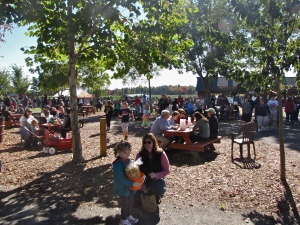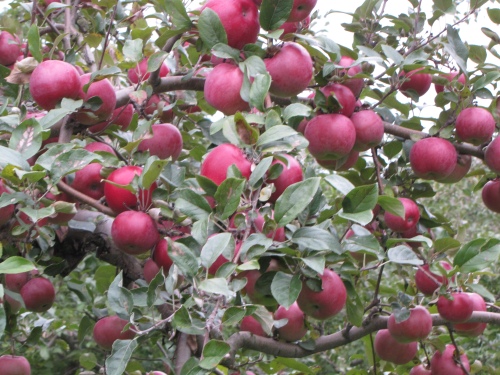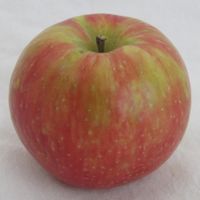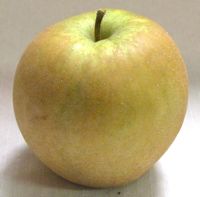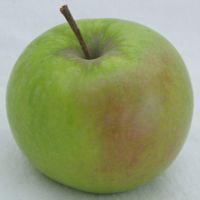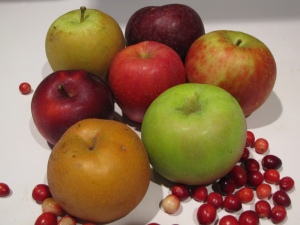
Jonagold apples are labeled “Better than Honeycrisp” at Tougas Family Farm, Northborough, Massachusetts (Russell Steven Powell photo)
THE 2014 NEW ENGLAND APPLE crop is decidedly uneven. Some orchards have plenty of fruit, some just miles away have been forced to close early after running out of fresh apples.
The region avoided major outbreaks of frost damage in the spring, hail in summer, or a fall hurricane, any of which can shrink the crop. But the 2014 New England harvest is smaller than usual for several reasons, including last year’s harsh winter, which damaged or killed trees in some orchards; spotty pollination during spring bloom, impacting whole orchards or certain varieties; and a larger-than-usual outbreak of the bacterial infection fire blight in all of the New England states except Maine.
Some orchards are down as much as 60 percent to 70 percent from a normal year. But many New England orchards have outstanding crops. Region-wide, there are plenty of beautiful, delicious apples of all varieties and sizes, a few of which are shown here.
So if you don’t find your favorite apple at your favorite orchard, don’t despair. Simply branch out to another New England orchard, or check your supermarket for local apples. Chances are you will not have to look far.
The Massachusetts photographs were taken Sunday, October 5, the Rhode Island orchards Monday, October 6.
Visit our website, New England Apples, for a list of the region’s orchards and to learn about New England apple varieties and where they are grown.
A heavy crop of late-season Topaz apples is among the varieties available at Tougas Family Farm, Northborough, Massachusetts (Russell Steven Powell photo)
TOPAZ is a disease-resistant variety from the Czech Republic that made its commercial debut in 1990. The small but active Czech Republic apple industry has been in the forefront of developing new disease-resistant varieties, including the scab-resistant Topaz and its parents, Rubin and Vanda.
Topaz is a medium to large apple with a red blush over a yellow skin. Its cream-colored flesh is crisp, and its flavor, initially more tart than sweet, mellows some in storage. There is a redder strain known as Crimson Topaz or Red Topaz.
PEOPLE SWARMED to New England’s orchards Sunday like bees to nectar after Saturday’s rain. Massachusetts orchards Red Apple Farm in Phillipston and Tougas Family Farm in Northborough are among the many orchards that have outstanding crops this fall.

Macoun apples are just coming in at Steere Orchard, Greenville, Rhode Island (Russell Steven Powell photo)
STEERE ORCHARD in Greenville, Rhode Island, is just now harvesting Macouns, more than a week later than usual.
Steere Orchard will celebrate its 10th annual “Applefest” this weekend, Sunday, October 12, and Columbus Day, Monday, October 13, from 9 a.m. to 6 p.m. In addition to sampling and picking apples, there will be hayrides, a farmers market, live music, and baked goods.
THERE ARE MORE apples remaining on the trees at Hill Orchards than neighboring Dame Farm and Orchard, both of Johnston, Rhode Island. The Macouns are nearly gone at Dame Farm and Orchard, which expects to be all picked out of all varieties by this weekend (there are plenty of fresh apples and other produce for sale in their farm store).
PIPPIN ORCHARD in Cranston, Rhode Island, still has some pick-your-own as well as fresh apples in its roadside store, but it is close to being picked out. Its cold storage room, usually full by now, is half full; even the orchard floor is unusually clean.
Pick-your-own apples are already gone at Phantom Farms in Cumberland, Rhode Island, but there are fresh apples and other goods for sale in their farm store and bakery.
Stripped of fruit, the orchard is still beautiful, fragrant, and peaceful, as Phantom Farms gradually transitions from standard-sized to dwarf and semi-dwarf trees.

A standard-sized apple tree towers over dwarf saplings at Phantom Farms, Cumberland, Rhode Island (Russell Steven Powell photo)
Eastford, Connecticut
Buell’s Orchard in Eastford, Connecticut, has a good supply of apples.
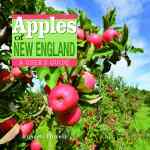 RUSSELL STEVEN POWELL will discuss apples and read from his new book, Apples of New England (Countryman Press), at several sites over the Columbus Day Weekend.
RUSSELL STEVEN POWELL will discuss apples and read from his new book, Apples of New England (Countryman Press), at several sites over the Columbus Day Weekend.
Photographer Bar Lois Weeks will make a joint appearance with him at Boothby’s Orchard and Farm Monday, October 13:
Saturday, October 11, 2 p.m.
80 Old Main St., Deerfield, Massachusetts
*
Monday, October 13, 11 a.m.
366 Boothby Rd., Livermore, Maine
*
Tuesday, October 14, 7:30 p.m.
Williamsburg Historical Society
4 North Main St., Williamsburg, Massachusetts

